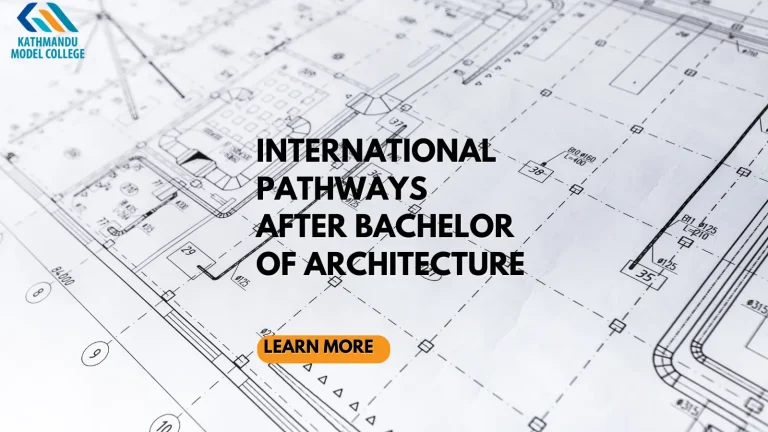
Bachelor of Architecture in Nepal: Course Overview and Scope
Bachelor of Architecture is a professional undergraduate degree in architecture that is focused on the art and science of designing and constructing buildings and environments.
The Bachelor of Architecture (B.Arch) in Nepal is a five-year (10 Semesters) professional undergraduate degree that gives major focus to architectural design, planning, and building construction.
Universities offering B.Arch in Nepal are:
- Tribhuvan University (TU)
- Kathmandu University (KU)
- Purbanchal University
- Pokhara University (PU)
Learn more about the CMAT Preparation Guide
Key aims of the Bachelor of Architecture (B.Arch) program in Nepal:
- To develop design skills in students, encouraging them to create functional, safe, and visually appealing structures that balance local and global influences.
- To provide technical expertise in construction materials, structural systems, and modern building.
- To integrate cultural heritage in students by promoting traditional Nepalese architecture alongside contemporary modern practices.
- To encourage sustainable design to address environmental challenges and promote eco-friendly solutions.
- To prepare students for professional practice through project management, teamwork, ethics, and to build licensing requirements.
- Emphasizing community needs, heritage conservation, and inclusive design to foster a sense of social responsibility in our students.
- Provide students with knowledge regarding research and innovation, helping them to tackle urbanization, sustainability, and emerging architectural trends.
- To refine the critical thinking skills in our graduates for lifelong practical learning and adaptability in the rapidly evolving field.
These objectives ensure that graduates are well-equipped to contribute meaningfully to Nepal’s built environment.
Academic Details
Core Subjects
Some common courses that all Universities offering the B.Arch program must cover the following subjects:
- Architectural Design Studio
- Building Construction and Materials
- History of Architecture
- Structural Design
- Building services
- Climatology and Environmental Sciences
- Trade, and more.
Year | Key Focus | Major Components |
1st year | Foundation | Design, Drawing, History, Materials |
2nd year | Core Skills | Residential Design, Structures, CAD |
3rd year | Advanced Topics | Public Buildings, Urban Design, Services |
4th year | Specialization | Sustainable design, Electives, Research |
5th year | Professional Prep | Thesis, internship, Portfolio |
- Internship/Practical Practice training: In the final year of the program, 6 months to 1 year must be mandatorily given to an internship and a job to earn a license in Nepal.
- Thesis statement: Usually, in the final year, students are required to submit a report regarding their research or design project.
Read more on Bsc.CSIT Entrance Preparation Guide
Course Duration
- The total duration of this course is five academic years.
- These five years are divided into ten semesters, each year consisting of two semesters.
- The credit hours vary with the institutions, but they are usually between 150 to 185 credit hours.
- Each semester typically lasts for 16 weeks of coursework, including project work.
Examination and Evaluation
- Students are required to pass regular in-semester exams, along with project works, practicals, and end-of-semester examinations.
- The evaluation criteria are divided into 4 categories:
- Internal evaluation consisting of classroom performance and interactions, presentations, and assignments
- Project Work and Written Report/Thesis
- Internal Examination
- End-semester Examination
Admission Process and Criteria
Eligibility Requirements
- Minimum degree of higher secondary education (+2, PCL, or equivalent) with a science stream.
- Minimum of at least grade C or a minimum of 45 % in all subjects.
- Mathematics must be a compulsory subject during their higher secondary education.
Entrance Examination
- All applicants must pass an entrance examination conducted by their preferred university.
- Applicants must complete the registration process to sit for the entrance exam.
- Students are to submit the following documents along with the registration fee:
- Academic certificates, including SEE/SLC marksheet, +2 or equivalent higher secondary education marksheet, and transcripts.
- Character Certificates
- Copy of citizenship card
- Transfer or Migration certificate, if applicable
- Questions in the examinations are generally on Mathematics, Physics, Chemistry, logical reasoning, and design aptitude.
- The questions are objective-based, with some universities using negative marking and a ranking system.
- The examination center details and admit card details will be provided by the university on its official website or by the college.
- Admission is highly competitive and is strictly based on the merit ranking entrance exam.
- Certain Universities or colleges may require a group discussion or interview, or an aptitude test after passing the main entrance exam.
Learn How to Prepare for Chartered Accountancy (CA) After +2 and the Cost of Study
Scope of the Bachelor of Architecture (B.Arch) Program in Nepal
The Bachelor of Architecture (B.Arch) program in Nepal develops skilled professionals responsible for addressing the country’s architectural challenges.
By combining technical knowledge with creative design, the B.Arch program emphasizes sustainable development, better urban planning, and conservation of the heritage of the country.
Students gain both theoretical and practical knowledge and practice in construction, technology, digital tools for designing, and culturally responsive design to meet both local needs and global standards.
The curriculum prepares graduates for diverse roles in Nepal’s evolving architectural built environment, backed by private practice and public sector projects.
Graduates in Nepal can pursue diverse career paths both within the country and internationally.
Key roles include:
- Architect: Act in a significant role, responsible for designing a variety of structures like residential homes, commercial buildings, institutional facilities, and organizations.
- Urban Planner: Individuals from this profession play a key role in shaping the layout and growth of cities and urban lifestyles with the help of systematic planning of the infrastructure, transportation system, housing, and public spaces to promote sustainability, along with comfort.
- Interior Designer: This role focuses mainly on creating interior environments that are not just visually appealing but also functional, safe, and aligned with the individual’s needs and preferences.
- Landscape Architect: Individuals from this role are responsible for creating sustainable outdoor spaces such as parks, gardens, colleges, and public malls with increased emphasis on ecology and comfort.
- Conservation/Restoration Specialist: These professionals work to preserve and restore heritage buildings and culturally significant sites, ensuring their historical integrity while adapting them for contemporary use when necessary.
- Construction Manager / Project Manager: They are responsible for managing construction projects from foundation to completion, managing timelines and deadlines, necessary resources, budgets, and teams for efficient delivery of the projects.
- Architectural Consultant / Advisor: They provide government bodies, private companies, and NGOs with their professional and expert guidance and design, building codes, materials, and project feasibility.
- Visualization Specialist / Illustrator: These professionals are responsible for delivering detailed architectural drawings, 3D visualizations, and digital renderings that help clients, stakeholders, and construction teams understand project designs and systematic planning.
- Real Estate Developer: These professionals are involved in the planning, financing, and execution of property development projects, often coordinating with architects, engineers, and investors to bring large-scale projects to life.
In summary, the B.Arch program in Nepal offers diverse career opportunities, from traditional architectural roles to specialized paths like sustainability consulting, Building Information Modeling (BIM) architect, academic environments, and private practice, with transferable skills of creativity, technology, and project management, which open doors beyond architecture into areas like policy, development, and planning.
While the Bachelor of Architecture (B.Arch) is a respected path for those specifically seeking careers in architecture, Kathmandu Model College (KMC) provides a diverse range of programs that may be a better overall choice for many students, especially those seeking broad opportunities, skill versatility, or strong placement prospects.
Exploring alternative paths alongside specialized programs like B.Arch can be valuable.
Broader skills offer flexibility and adaptability in a changing job market, keeping future options open.
Read more on the Engineering Entrance Preparation Guide
How KMC courses can be your alternative?
KMC, widely recognized as one of the best college in Kathmandu, Nepal, offers you various TU-verified courses since 2003.
We have proudly secured the Quality Assurance and Accreditation (QAA) certification from the University Grant Commission (UGC), and were honored by the award of Nepal’s Best Campus 2080 B.S.
We provide students with combined modern teaching approaches, distinguished by faculty, and exceptional student outcomes.
We provide you wide range of programs like:
- Bachelor of Business Administration (BBA)
- Bachelor of Business Studies (BBS)
- Bachelor of Business Management (BBM)
- Masters of Business Studies (MBS)
- Bachelor of Computer Applications (BCA)
- Bachelor of Arts (BA)
- Bachelor of Social Work (BSW)
- Master of Arts (MA)
KMC’s Business Administration degrees offer modern classrooms, company internships, and strong job placement support, preparing students for success in business, banking, and management.
Our Bachelor of Computer Application program, verified by TU, provides guided experience in computer labs, backed by modern technology, real coding projects, and IT internships, making sure that graduates from our college are prepared to explore their career roles in the demanding world of tech.
Students from the Arts and Humanities faculty can benefit from expert guest lectures, multiple opportunities for research, and vibrant activities like debates and publishing, helping build practical skills for roles in education, media, mental health, and development.
The BSW degree offered by our college features fieldwork with NGOs and real-world community projects, giving graduates the practical experience required to bring change in the environment of social service.
Our major goal is to transform our students into professionals, ready to step into the career world through industry-focused training, hands-on experience, mentorship, and guidance from the experts.
Our college graduates stand out in Nepal’s job market, and beyond, with the skills, adaptability, and vision to lead in their fields.

























